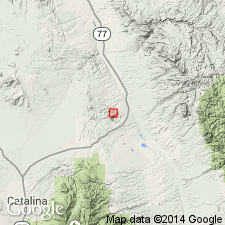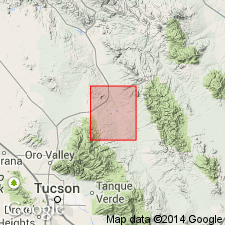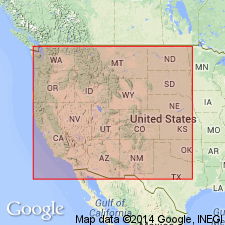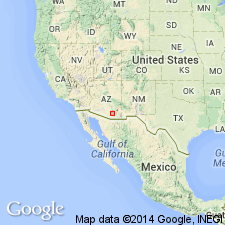
- Usage in publication:
-
- Oracle granite
- Modifications:
-
- Original reference
- Dominant lithology:
-
- Granite
- AAPG geologic province:
-
- Southwestern Basin-and-Range region
Summary:
Pg. 8-9. Oracle granite. Prevailingly a coarse-grained porphyritic biotite granite with large pink or salmon-colored feldspars 1.25 to 1.5 inches across that gives rock a pink or gray mottled appearance on fresh surfaces. Groundmass composed of uniformly sized (0.2-inch diameter) grains of clear white feldspar and glassy quartz with greenish-black masses of biotite and magnetite. Composition suggests that rock should be classed as quartz monzonite rather than granite. Surface exposures of light-buff color. Oldest rock exposed in Mammoth area. Intruded by numerous dikes and other small bodies of aplite and andesite porphyry. Unconformably underlies Apache series [Apache group]. Age is Precambrian. Report includes geologic maps, cross sections.
Type locality not designated. Exposed in Mammoth mining camp area, 3 mi southwest of village of Mammoth. Mapped area almost entirely in W/2 sec. 26 and E/2 sec. 27, T. 8 S., R. 16 E., on east flank of Black Hills. Also exposed in area of village of Oracle on northern slope of Santa Catalina Mountains, Pinal Co., southeastern AZ. Named from village of Oracle.
[According to GNU records (USGS DDS-6; Denver GNULEX, Oct. 24, 1990) type not designated and named from Oracle.]
Source: US geologic names lexicon (USGS Bull. 1200, p. 2841-2842); supplemental information from GNU records (USGS DDS-6; Denver GNULEX).

- Usage in publication:
-
- Oracle Granite of Peterson (1938)
- Modifications:
-
- Overview
- AAPG geologic province:
-
- Southwestern Basin-and-Range region
Summary:
Pg. 8-10. Quartz monzonite (Oracle Granite of Peterson, 1938). A coarse-grained porphyritic rock. Consists of phenocrysts of microperthite and K-feldspar in a medium-grained hypidiomorphic granular matrix. Phenocrysts are pink, whereas matrix feldspars (plagioclase and lesser K-feldspar) are white. Accessory minerals are sphene, zircon, and apatite. Present on west side of Mammoth quadrangle, Pinal County, Arizona. South of Mogul fault, unconformably underlies Scanlan Conglomerate Member of Pioneer Formation of Apache Group. Unconformity is profound; elsewhere it separates Pinal Schist from Apache Group. Cut by aplite dikes. Age is Precambrian. Average Pb-alpha age on zircon about 1,250 +/-140 Ma (T.W. Stern [personal commun.]); depending on half life figure used for rubidium-87, Rb-Sr age on biotite 1,350 Ma or 1,450 Ma (Giletti and Damon, 1961, GSA Bull., v. 72, no. 4, p. 639-644). Report includes geologic map, cross section, chemical analysis.
Source: Publication.

- Usage in publication:
-
- Oracle Granite*
- Oracle Granite of Peterson (1938)*
- Modifications:
-
- Geochronologic dating
- AAPG geologic province:
-
- Southwestern Basin-and-Range region
Summary:
Pg. 7, geologic time scale (inside front cover). Quartz monzonite (Oracle Granite of Peterson, 1938, and Oracle Granite). Samples from drill-holes (depth-intervals about 329 to 340 m, 379 m, 395 m, and 427 m), in San Manuel area, Lat. 32 deg. 41 min. 00 sec. N., Long. 110 deg. 40 min. 30 sec. W., Mammoth quadrangle, Pinal County, Arizona, yielded Pb-alpha ages from 1,320 +/-150 Ma to 1,200 +/-130 Ma (zircon); reconnaissance ages [Precambrian Y]. Ages calculated using decay constants of Steiger and Jager, 1977 (Earth Planet. Sci. Letters, v. 36, p. 359-362.
Source: Publication.

- Usage in publication:
-
- Oracle Granite
- Modifications:
-
- Geochronologic dating
- AAPG geologic province:
-
- Southwestern Basin-and-Range region
Summary:
Oracle Granite. K-Ar ages: on biotite 1,380 +/-39 Ma and 1,430 +/-40 Ma; on muscovite 1,425 +/-40 Ma; on plagioclase 1,425 +/-40 Ma. Rb-Sr ages: on biotite 1,410 +/-40 Ma; on whole-rock 1,380 Ma. U-Pb age on zircon 1,440 Ma. Exposed in area of village of Oracle, Pinal Co., southeastern AZ. Ruin Granite, near Globe, AZ, is same age as Oracle, and might be same rock as Oracle.
Source: Modified from GNU records (USGS DDS-6; Denver GNULEX).
For more information, please contact Nancy Stamm, Geologic Names Committee Secretary.
Asterisk (*) indicates published by U.S. Geological Survey authors.
"No current usage" (†) implies that a name has been abandoned or has fallen into disuse. Former usage and, if known, replacement name given in parentheses ( ).
Slash (/) indicates name conflicts with nomenclatural guidelines (CSN, 1933; ACSN, 1961, 1970; NACSN, 1983, 2005, 2021). May be explained within brackets ([ ]).

